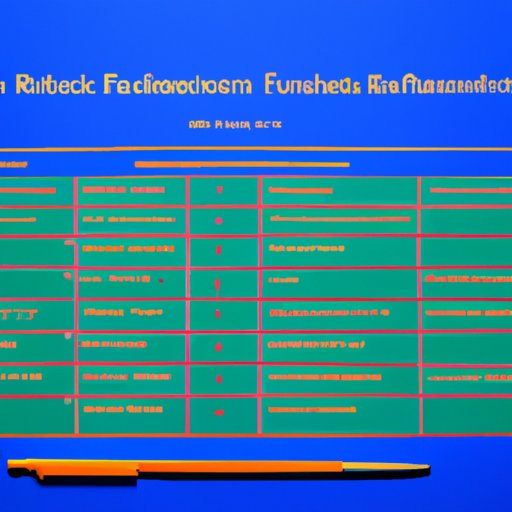Introduction
A conceptual framework for financial reporting is a set of standards and principles used by accountants and auditors when preparing financial statements. It serves as a guide for making decisions regarding the preparation, presentation, and disclosure of financial information. The purpose of this framework is to ensure that all financial information is presented accurately and consistently.

Exploring the Basics of a Conceptual Framework for Financial Reporting
The conceptual framework for financial reporting is comprised of three main components: assumptions, principles, and objectives. Assumptions provide the basis for the framework, while principles provide guidance on how to apply the assumptions. Objectives are specific goals that must be achieved in order for the framework to be effective.
The assumptions used in a conceptual framework for financial reporting include the economic entity assumption, the going concern assumption, and the accrual basis of accounting. The economic entity assumption states that the activities of a business should be reported separately from those of its owners. The going concern assumption assumes that a business will continue to operate indefinitely. The accrual basis of accounting requires that transactions and events be recognized in the period in which they occur, rather than when cash is received or paid out.
The principles used in a conceptual framework for financial reporting are designed to ensure that financial statements are prepared in accordance with generally accepted accounting principles (GAAP). These principles include consistency, materiality, reliability, prudence, and completeness. Consistency requires that similar transactions and events be reported in a similar manner. Materiality requires that only items that have a significant impact on the financial statements be included. Reliability requires that information be verifiable and free from errors. Prudence requires that losses be recognized sooner rather than later. Completeness requires that all relevant information be disclosed.
The objectives of a conceptual framework for financial reporting are to provide useful information to decision makers and help them assess the performance and position of a business. To achieve these objectives, there are four key qualitative characteristics that must be present in financial statements: relevance, faithful representation, comparability, and understandability. Relevance means that the information provided is pertinent to the decision being made. Faithful representation means that the information accurately reflects the underlying transactions and events. Comparability means that information can be compared from one period to another. Understandability means that the information is easy to interpret.
A Comprehensive Guide to Establishing a Conceptual Framework for Financial Reporting
Establishing a conceptual framework for financial reporting involves several steps. First, it is important to identify and clarify the key concepts used in the framework. This includes understanding the assumptions, principles, and objectives that are used. Next, the elements of financial reporting must be defined. This includes determining the types of information that should be included in the financial statements, such as assets, liabilities, revenues, expenses, and disclosures. Once the elements have been identified, the next step is to analyze the transactions and events that need to be reported. This involves determining how each transaction or event should be classified and measured.
Once the key concepts and elements have been established, the next step is to create a plan to implement the framework. This plan should include the procedures that will be used to prepare the financial statements, the format in which the information will be presented, and the criteria that will be used to make decisions about the disclosure of information. Lastly, it is important to test the framework to ensure that it meets the objectives that have been set.

An Overview of How to Develop a Conceptual Framework for Financial Reporting
Developing a conceptual framework for financial reporting requires a deep understanding of the key concepts involved. This includes identifying and clarifying the assumptions, principles, and objectives that will be used in the framework. It also involves defining the elements of financial reporting and analyzing the transactions and events that need to be reported.
When identifying the key concepts, it is important to consider the nature and measurement of assets and liabilities, revenues and expenses, and disclosures. For assets and liabilities, it is necessary to determine the type of asset or liability, its measurement, and how it should be reported. For revenues and expenses, it is important to consider the timing of when they should be recognized and the methods used to measure them. Finally, for disclosures, it is important to consider whether additional information needs to be disclosed in order to provide a complete picture of the company’s financial position.
Understanding the Key Components of a Conceptual Framework for Financial Reporting
In addition to understanding the key concepts, it is important to understand the components of a conceptual framework for financial reporting. This includes understanding the assumptions, principles, and objectives that will be used, as well as the elements that will be included in the financial statements. It is also important to analyze the transactions and events that need to be reported in order to ensure that the financial statements are accurate and complete.
It is also important to consider the nature and measurement of assets and liabilities. This includes understanding the type of asset or liability, its measurement, and how it should be reported. For revenues and expenses, it is necessary to consider the timing of when they should be recognized and the methods used to measure them. Finally, for disclosures, it is important to consider whether additional information needs to be disclosed in order to provide a complete picture of the company’s financial position.

Steps to Building an Effective Conceptual Framework for Financial Reporting
Once the key concepts and components of the framework have been identified and clarified, the next step is to establish the framework’s goals and objectives. This includes setting specific targets that must be achieved in order for the framework to be effective. Once the goals and objectives have been established, the next step is to gather and analyze the information needed to develop the framework. This includes identifying the assumptions, principles, and objectives to be used, as well as the elements to be included in the financial statements.
Once the information has been gathered and analyzed, the next step is to test the framework to ensure that it meets the objectives that have been set. This includes testing the framework to ensure that it produces reliable and useful information. Finally, once the framework has been tested and approved, it is ready to be implemented. This includes creating the procedures and formats that will be used to prepare the financial statements.
Examining the Benefits of Having a Conceptual Framework for Financial Reporting
Having a conceptual framework for financial reporting offers numerous benefits. One of the most important benefits is improved decision-making. By providing reliable and useful information, decision makers are better able to assess the performance and position of a business. Additionally, having a framework in place increases the reliability of financial statements, as they are prepared in accordance with GAAP. Lastly, having a framework in place enhances accountability, as it ensures that all financial information is presented accurately and consistently.
Conclusion
A conceptual framework for financial reporting is a set of standards and principles used by accountants and auditors when preparing financial statements. It provides a guide for making decisions regarding the preparation, presentation, and disclosure of financial information. The framework is comprised of assumptions, principles, and objectives, and it is designed to provide useful information to decision makers and help them assess the performance and position of a business. Establishing a framework involves several steps, including identifying and clarifying the key concepts, defining the elements of financial reporting, and testing the framework to ensure that it meets the objectives. Having a framework in place offers numerous benefits, including improved decision-making, increased reliability, and enhanced accountability.
(Note: Is this article not meeting your expectations? Do you have knowledge or insights to share? Unlock new opportunities and expand your reach by joining our authors team. Click Registration to join us and share your expertise with our readers.)
